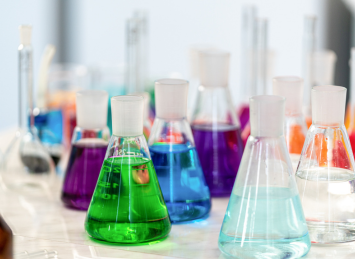Atomic Structure and Periodic Table
- Subatomic particles
- Atomic number, mass number, and isotopes
- Electron configuration (Bohr and quantum models)
- Periodic trends (atomic radius, ionization energy, etc.)
Covalent Bonding and Molecular Geometry
- Covalent bonding principles
- Lewis structures and resonance
- VSEPR theory
- Molecular polarity and shape
Covalent Bonding: Orbitals
- Valence Bond Theory
- Hybridization (sp, sp², sp³)
- Molecular Orbital Theory (introductory level)
- Ionic and Metallic Bonding
- Ion formation and lattice energy
- Properties of ionic and metallic substances
- Crystal structures and conductivity
Chemical Reactions
- Types of chemical reactions (synthesis, decomposition, etc.)
- Predicting products
- Balancing chemical equations
- Activity series and reactivity
Stoichiometry
- Mole concept and conversions
- Empirical and molecular formulas
- Limiting reactants and percent yield
- Reaction calculations
States of Matter and Gas Laws
- Kinetic Molecular Theory
- Pressure, volume, temperature relationships
- Boyle’s, Charles’s, Avogadro’s, and Ideal Gas Law
- Gas mixtures and partial pressure
Thermochemistry
- Heat vs. temperature
- Calorimetry
- Enthalpy changes and thermochemical equations
- Hess’s Law
Solutions and Mixtures
- Solubility and concentration (molarity, percent, ppm)
- Dissociation and hydration
- Colligative properties
Acids and Bases
- Properties and definitions (Arrhenius, Brønsted–Lowry)
- Strong vs. weak acids/bases
- pH and pOH
- Neutralization reactions
Acid-Base Equilibria
- Acid and base dissociation constants (Ka and Kb)
- pKa and pKb
- Buffers and buffer calculations
- Titration curves and indicators
Solubility and Complex Ion Equilibria
- Solubility product constant (Ksp)
- Common ion effect
- Precipitation and selective precipitation
- Complex ion formation and equilibrium
Chemical Kinetics and Equilibrium
- Reaction rate factors
- Rate laws and reaction mechanisms
- Equilibrium constants (Kc and Kp)
- Le Châtelier’s Principle
Nuclear Chemistry
- Types of radioactive decay
- Nuclear reactions: fission and fusion
- Half-life calculations
- Applications in medicine and energy
Spontaneity & Entropy
- Introduces entropy as a measure of disorder and explores the Second Law of Thermodynamics.
- Students learn to calculate Gibbs Free Energy (ΔG) and determine whether reactions are spontaneous.
- Emphasis on the relationship between enthalpy, entropy, and temperature in driving chemical processes.
Electrochemistry
- Covers redox reactions, balancing methods, and electrochemical cells (galvanic and electrolytic).
- Students learn to interpret standard reduction potentials and calculate cell voltages.
- Real-world applications include batteries, corrosion, and electrolysis.
The Representative Elements
- Focuses on the chemistry of Groups 1–2 and 13–18 in the periodic table.
- Students explore common reactions, physical properties, and real-life uses of elements like alkali metals, halogens, and noble gases.
- Trends like reactivity and electronegativity are reinforced across groups.
Transition Metals & Coordination Chemistry
- Focuses on the unique behavior of transition metals, including variable oxidation states and colored compounds.
- Covers ligands, naming coordination complexes, and the basics of crystal field theory.
- Highlights real-world applications in medicine and biology (e.g., hemoglobin).
Organic and Biological Molecules
- Introduces structure and reactivity of organic compounds like hydrocarbons and functional groups.
- Explores key biomolecules: carbohydrates, proteins, lipids, and nucleic acids.
- Connects chemistry to biological systems and polymers used in everyday life.
